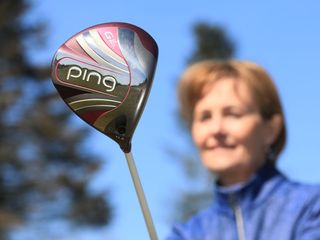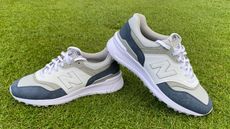Women's Golf Clubs: How To Find The Right Clubs For Your Game
Here we give important insight into what you should be looking out for when finding the right women's clubs.


Women's Golf Clubs: How To Find The Right Clubs For Your Game
When women are considering new golf equipment it is really important that they get it right and buy golf clubs that complement their ability and suit their swing. Here is a guide to give you a better understanding of a golf club’s key components to help you make a purchase decision. Once you have given this a read, we recommend checking out our club specific buyers guides throughout this piece too so you can narrow your focus down even further.
Women's Golf Clubs: How To Find The Right Clubs For Your Game
Shaft
Women generally have slower swing speeds, so are better suited to clubs fitted with a soft flex graphite shaft. This lightweight material enables an effortless swing with increased clubhead speed, and subsequently more distance. Women with faster swing speeds should opt for stronger flex steel-shafted clubs for greater control. Shafts come in different lengths, but as a rule women’s golf clubs are on average almost 2” shorter than men’s clubs. A shaft that is too long will have a negative impact on control and accuracy.
Clubheads
Clubheads come in a variety of designs and colors, not only to suit a golfer’s ability, but also to offer pleasing and confidence-boosting aesthetics when players address the ball.
Drivers: Women’s drivers generally have a smaller and lighter clubhead than men’s drivers to help generate greater clubhead speed. Modern head shapes allow weights to be positioned for a low, deep centre of gravity to improve MOI, which makes the club ultra forgiving and less prone to twisting at impact. Some of the latest drivers (and fairway woods) have moveable weights to help dial-in a player’s preferred shot shape and trajectory.
Irons: Oversized cavity backed clubheads suit beginners and mid-high handicappers as the wider sole and a low centre of gravity make it easier to get the ball airborne with maximum forgiveness. However, this is at the expense of workability, so better players who strike their irons more consistently will veer towards traditional blade irons, or include a mix of both.

Hosel
The hosel is the component that connects the shaft to the clubhead and nowadays it is more common for a driver, fairway woods and hybrids to have an adjustable hosel that alters the loft and face angle. This technology allows women who have a tendency to slice or hook the ball, or require a different trajectory to maximise distance, the ability to tinker with the set-up of the club to suit their swing.
Get the Golf Monthly Newsletter
Subscribe to the Golf Monthly newsletter to stay up to date with all the latest tour news, equipment news, reviews, head-to-heads and buyer’s guides from our team of experienced experts.
Grip
Do not underestimate the importance of having the right size grip. If a grip is too small then you are likely to grip the club too tightly, causing tension to build in your arms and shoulders, which in turn prevents you from generating maximum clubhead speed.
It will also encourage too much hand action, forcing the clubface to close prematurely, resulting in a pulled or hooked shot. A grip that is too large has the opposite effect. With less hand action, this will encourage the clubhead to open at impact and exaggerate a slice. The easiest way to determine the size of your grip is to measure your hands. There are typically only four grip sizes to choose from and the undersized grip that measures less than 7” from the wrist crease is most common for women.

Loft
Each golf club has a different loft angle. To put simply, a club with a lower loft like a driver, will send the ball on a gentle climb with greater distance, whereas the ball will travel far steeper off the clubface of a pitching wedge.
Driver lofts vary between 8-14 degrees and a loft should be selected based on your clubhead speed. Most women’s drivers are designed with a higher loft between 11-12 degrees or more, to suit slower swing speeds (90mph and lower) for easy launch. Stronger players that can generate a faster clubhead speed (100mph and above) will suit a driver with a loft of 10 degrees or less.
Custom Fitting
Above all else and whatever your ability, a custom fitting session is strongly recommended. It is a misconception that the service, which is offered by a number of manufacturers, is just for elite players and professionals. For beginners, custom fitting should be considered as part of the learning process to boost confidence and help maximize potential.
Alison Root has over 25 years experience working in media and events, predominantly dedicated to golf, in particular the women’s game. Until 2020, for over a decade Alison edited Women & Golf magazine and website, and is now the full-time Women's Editor for Golf Monthly. Alison is a respected and leading voice in the women's game, overseeing content that communicates to active golfers from grassroots through to the professional scene, and developing collaborative relationships to widen Golf Monthly's female audience across all platforms to elevate women's golf to a new level. She is a 16-handicap golfer (should be better) and despite having had the fantastic opportunity to play some of the best golf courses around the world, Kingsbarns in Scotland is her favourite.
-
 'Gator Netting Is In Place' - Chevron Championship Venue Prepared For 'Safe' Winner's Jump
'Gator Netting Is In Place' - Chevron Championship Venue Prepared For 'Safe' Winner's JumpA tradition which began at the tournament's previous home could continue this year - if the champion is feeling brave enough...
By Jonny Leighfield Published
-
 New Balance 997 SL Golf Shoe Review
New Balance 997 SL Golf Shoe ReviewNew Balance produce some extremely stylish footwear and, in this review, Matt Cradock takes their spikeless 997 SL onto the course
By Matt Cradock Published
-
 Is Women's Golf Paying The Price Of A Jam-Packed Tournament Schedule?
Is Women's Golf Paying The Price Of A Jam-Packed Tournament Schedule?Yet again women's golf is playing second fiddle when the first Major of the year, The Chevron Championship, has to compete against a signature PGA Tour event
By Alison Root Published
-
 ‘I Want To Show My Physique Off, How Strong I Am As Well And That I Can Be Glamorous’ - Charley Hull On Fashion, ADHD Diagnosis And The Match Everyone Wants To See
‘I Want To Show My Physique Off, How Strong I Am As Well And That I Can Be Glamorous’ - Charley Hull On Fashion, ADHD Diagnosis And The Match Everyone Wants To SeeOne of the world's best female golfers, Charley Hull, tells her story in the latest episode of Sky Sports Editions
By Alison Root Published
-
 The Steps That Helped Me Go From Beginner To Single Figures In A Year
The Steps That Helped Me Go From Beginner To Single Figures In A YearHere's Jess Ratcliffe's plan of how she achieved her incredible handicap cut
By Jess Ratcliffe Published
-
 Can You Lose Weight Playing Golf?
Can You Lose Weight Playing Golf?Golf is a long walk and great exercise, but you need to make smart choices if the sport is part of your weight loss programme
By Katie Dawkins Published
-
 ANWA Was Terrific, But Should Augusta Be Doing More To Support The Women's Game?
ANWA Was Terrific, But Should Augusta Be Doing More To Support The Women's Game?We consider why the world's best professional female golfers should be given an opportunity to compete at Augusta
By Alison Root Published
-
 Which Female Golfers Have Won Four Or More Consecutive LPGA Titles?
Which Female Golfers Have Won Four Or More Consecutive LPGA Titles?We take a look at the players that have enjoyed an incredible winning streak on the LPGA Tour
By Alison Root Published
-
 7 Ways To Tell If Your Golf Coach Is Right For You
7 Ways To Tell If Your Golf Coach Is Right For YouCoaches can be an invaluable part of your progression in golf. Here are some tips to ensure you select the right one
By Emma Booth Published
-
 What Is Augusta National's Yardage Difference Between ANWA And The Masters?
What Is Augusta National's Yardage Difference Between ANWA And The Masters?Hosted a week apart at Augusta National, we take a look at the difference in hole yardages at ANWA and the Masters
By Alison Root Published